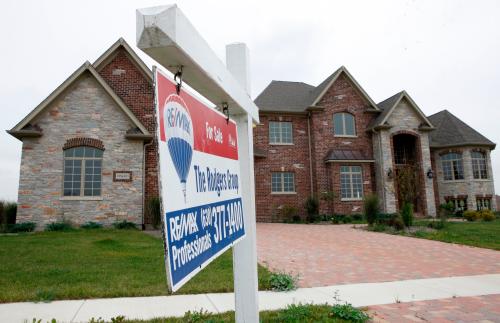American political leaders are currently focused on policies to address the health and economic implications of the COVID-19 pandemic. Nevertheless, it is not too soon to consider policy changes that could be beneficial to implement after the crisis has passed.
The U.S. faces two related and persistent threats to long-term, shared prosperity: growing inequality and rising federal debt. Inequality, especially wealth inequality, has risen sharply over the past 40 years. Children from different socioeconomic backgrounds do not have the same opportunities to achieve the American Dream. The Black-white gap in social mobility is especially concerning. The government’s budget outlook has long been a concern, with the federal debt projected to rise continually relative to the size of the economy, because of an aging population, rising healthcare costs, and inadequate revenues. The pandemic has made each problem more difficult to solve.
Policy makers should be looking for ways to address both issues. One place to start is by raising taxes on the most well-to-do households. During the Democratic primary, there were several proposals for a wealth tax, which would target the richest Americans and raise substantial amounts of revenue. Although a wealth tax would face difficult questions regarding its administrability and constitutionality, proposals for such taxes have re-energized the debate about taxing the wealthy. In some ways, the discussion has shifted from debating whether the rich should pay more in taxes toward determining the best way to achieve that goal.
In this policy brief, we consider the virtues of expanding the estate tax. Coupled with the gift and generation-skipping tax, the estate tax directly targets the intergenerational transfer of wealth. Whether it is ultimately borne by decedents or inheritors, the estate tax is extremely progressive. Inheritances are a major contributor to growing wealth inequality—large inheritances tend to flow to already wealthy heirs. The top ten percent of households by wealth receive 56 percent of all intergenerational transfers, while the bottom half receives only eight percent.
The estate tax is already part of the tax code. It has been administered – albeit imperfectly – for decades.
As a backstop to the income tax, the estate tax raises a significant share of its revenue from taxing the capital gains that wealthy decedents have avoided paying while alive. The estate tax also encourages charitable giving, both by providing a deduction for charitable gifts and by amplifying the effect of the income tax deduction for charitable giving.
Using a newly developed model based on household-level wealth and a mortality adjustment based on recent academic research, we present revenue estimates that show that under a variety of policy scenarios – including returning the (inflation-adjusted) exemption threshold and the estate tax rate schedule to their values in recent decades – an expanded estate tax could raise significant amounts of revenue.
Building an Estate Tax Calculator
To generate household and aggregate wealth, we use data from the 2016 Survey of Consumer Finances (SCF), a triennial survey conducted by the Federal Reserve Board. The SCF provides detailed information on households’ assets and liabilities and oversamples high-wealth households.1
In married households, each member of the couple is assumed to own half the wealth for tax filing purposes. Thus, every single householder and both members of a married couple are potential decedents for the purpose of predicting estate tax filings.
The probability of death for each potential decedent derives from a model of differential mortality based on recent work from Raj Chetty and his colleagues. This model is highly differentiated at the top of the distribution, making it well suited for predicting the distribution of deaths among people who are likely to be subject to the estate tax. A gross estate filing occurs when a potential decedent with wealth above the tax filing threshold is simulated to die in the current year.
Following established IRS practices, we apply a series of market value adjustments across four broad SCF asset classes: financial assets like stocks and bonds, businesses, real estate, and an “other” category that includes assets like art and vehicles.2 There are inherent uncertainties associated with the value of assets like businesses and real estate. We make downward adjustments in these values since the IRS routinely accepts a value at the lower end of the plausible range for tax filing purposes.
Using Census population data, we reweight the 2016 data to “age” the population forward to 2020. We then use Financial Accounts data to inflate real asset values from 2016 to 2020 across the same four broad wealth types used in the valuation adjustments. This produces the 2020 estimates of the distribution of household wealth. By construction, the sum of population-weighted inflated asset values grows in line with Financial Account aggregates between 2016 and 2020.
To produce estimates of taxable estate, we start with each potential decedent’s gross estate and apply a series of deductions, including spousal, charitable, attorney fees, funeral expenses, and executor fees, to mimic the behavior under the current estate tax.
We then run taxable estates through an estate tax calculator, yielding a revenue estimate.3
Benchmarking the Estate Tax Calculator
Table 1 shows the historical number and value of gross estates for the years 1995, 1998, 2001, and 2004, generated using the historical SCF data files for each of those years. The actual and simulated values are similar, suggesting that our model does a good job of predicting the value of estates. While the simulated value of closely held businesses is high, some of that gap is likely due to misclassification of business versus financial assets.
Table 1. Actual and Simulated Gross Estate Filings, 1995 to 2004
| Actual Estate Tax Filings | ||||||
| Size of Gross Estate | Number of Estates | Total Value of Gross Estates | Value of Closely Held Business | Value of Real Estate | Value of Financial Assets | Value of Other Assets |
| < $5 million | 80,699 | $ 112,732 | $ 6,445 | $ 25,966 | $ 78,125 | $ 2,056 |
| $5-10 million | 2,926 | 19,995 | 2,293 | 3,440 | 13,747 | 445 |
| $10-20 million | 1,028 | 13,990 | 2,195 | 2,023 | 9,373 | 291 |
| > $20 million | 528 | 28,668 | 7,370 | 2,297 | 17,627 | 1,129 |
| All | 85,181 | 175,385 | 18,302 | 33,727 | 118,872 | 3,922 |
| Simulated Estate Tax Filings | ||||||
| Size of Gross Estate | Number of Estates | Total Value of Gross Estates | Value of Closely Held Business | Value of Real Estate | Value of Financial Assets | Value of Other Assets |
| < $5 million | 72,160 | $ 112,498 | $ 15,797 | $ 24,943 | $ 69,036 | $ 2,722 |
| $5-10 million | 4,404 | 30,357 | 7,201 | 4,184 | 18,228 | 744 |
| $10-20 million | 1,872 | 23,930 | 4,443 | 4,743 | 14,522 | 223 |
| > $20 million | 786 | 32,150 | 8,563 | 1,672 | 19,882 | 2,034 |
| All | 79,221 | 198,935 | 36,004 | 35,541 | 121,667 | 5,722 |
| Ratio of Simulated to Actual Estate Tax Filings | ||||||
| Size of Gross Estate | Number of Estates | Total Value of Gross Estates | Value of Closely Held Business | Value of Real Estate | Value of Financial Assets | Value of Other Assets |
| < $5 million | 89% | 100% | 245% | 96% | 88% | 132% |
| $5-10 million | 150% | 152% | 314% | 122% | 133% | 167% |
| $10-20 million | 182% | 171% | 202% | 234% | 155% | 77% |
| > $20 million | 149% | 112% | 116% | 73% | 113% | 180% |
| All | 93% | 113% | 197% | 105% | 102% | 146% |
| Note: Averages of 1995, 1998, 2001, and 2004 actual and simulated values. Values are in millions of dollars. | ||||||
Table 2 shows that our estimates also match the historical number and value of taxable estates fairly well. There is some variability at the top of the distribution—the model generally simulates too much taxable wealth among estates between $10 million and $20 million, and too little in the greater than $20 million range, which may be due to the relatively small SCF samples in those years combined with the probabilistic assignment of spousal and charitable deductions, which often make a large (gross) estate non-taxable.
Table 2. Actual and Simulated Taxable Estate Filings, 1995 to 2004
| Actual Estate Tax Filings | ||||||
| Size of Gross Estate | Number of Estates | Total Value of Gross Estates | Value of Closely Held Business | Value of Real Estate | Value of Financial Assets | Value of Other Assets |
| < $5 million | 37,621 | $ 56,777 | $ 2,231 | $ 11,449 | $ 42,038 | $ 923 |
| $5-10 million | 1,818 | 12,551 | 1,118 | 1,861 | 9,224 | 289 |
| $10-20 million | 689 | 9,408 | 1,226 | 1,204 | 6,710 | 206 |
| > $20 million | 399 | 21,901 | 4,990 | 1,614 | 14,202 | 889 |
| All | 40,526 | 100,636 | 9,563 | 16,127 | 72,174 | 2,308 |
| Simulated Estate Tax Filings | ||||||
| Size of Gross Estate | Number of Estates | Total Value of Gross Estates | Value of Closely Held Business | Value of Real Estate | Value of Financial Assets | Value of Other Assets |
| < $5 million | 35,752 | $ 53,621 | $ 6,299 | $ 13,063 | $ 36,370 | $ 1,437 |
| $5-10 million | 2,394 | 15,247 | 3,919 | 2,133 | 10,426 | 424 |
| $10-20 million | 1,236 | 13,982 | 2,426 | 3,975 | 9,113 | 114 |
| > $20 million | 383 | 13,076 | 3,745 | 863 | 9,994 | 937 |
| All | 39,765 | 95,925 | 16,388 | 20,034 | 65,902 | 2,912 |
| Ratio of Simulated to Actual Estate Tax Filings | ||||||
| Size of Gross Estate | Number of Estates | Total Value of Gross Estates | Value of Closely Held Business | Value of Real Estate | Value of Financial Assets | Value of Other Assets |
| < $5 million | 95% | 94% | 282% | 114% | 87% | 156% |
| $5-10 million | 132% | 121% | 351% | 115% | 113% | 147% |
| $10-20 million | 180% | 149% | 198% | 330% | 136% | 55% |
| > $20 million | 96% | 60% | 75% | 53% | 70% | 105% |
| All | 98% | 95% | 171% | 124% | 91% | 126% |
| Note: Averages of 1995, 1998, 2001, and 2004 actual and simulated values. Values are in millions of dollars. | ||||||
Because the model simulates taxable estates well, applying the brackets and rates in force during the given year will generate simulated revenues that are close to actual values, with the caveat that gift taxes, generation-skipping taxes, and state death tax credits need to be addressed. The IRS publishes several concepts of estate tax liability in its annual reports, and the concept closest to what comes directly out of our simulation model is “tentative tax” less “unified credit.” The IRS reported value for that measure of estate tax liability averaged $25 billion over the four years (1995, 1998, 2001, and 2004) we use in the benchmark exercise. The model generates a value of $30 billion.
Revenue Estimates of an Expanded Estate Tax—Historical Examples
Over the past 80 years, the estate tax has shrunk in importance as a revenue source. The top estate tax rate has fallen from 77 percent in 1976 to 40 percent currently. A series of legislated changes raised the exemption threshold from $600,000 in 1987 to $11.6 million today ($23.2 million for married couples). The tax was even temporarily repealed in 2010. Most recently, the exemption threshold was doubled in the Tax Cuts and Jobs Act of 2017.
We apply three historical estate tax regimes—1982, 2001, and 2004—to the 2020 data. To do so, we adjust the exemption thresholds and tax brackets for inflation using PCE and apply the relevant tax rates.4
Table 3 shows the exemption threshold and rate schedules for these three regimes. The inflation-adjusted 1982 regime has an exemption level of $520,000. The rates rise steadily up to a maximum of 65 percent for every dollar above $9,330,000. For 2001, the rate schedule begins after $940,000 and rises to 55 percent after $4,160,000. The 2004 schedule is the simplest of the three. The exemption level is $1,970,000 with a fairly flat rate schedule that maxes out at 48 percent after $2,620,000.
Table 3. Historical Estate Tax Regimes Adjusted for Inflation
| 1982 | 2001 | 2004 | |||
| Brackets | Marginal Rate | Brackets | Marginal Rate | Brackets | Marginal Rate |
| $520,000 | 0% | $940,000 | 0% | $1,970,000 | 0% |
| $580,000 | 32% | $1,040,000 | 37% | $2,620,000 | 45% |
| $1,170,000 | 34% | $1,390,000 | 39% | >$2,620,000 | 48% |
| $1,750,00 | 37% | $1,730,000 | 41% | ||
| $2,330,000 | 39% | $2,080,000 | 43% | ||
| $2,910,000 | 41% | $2,780,000 | 45% | ||
| $3,500,000 | 43% | $3,470,000 | 49% | ||
| $4,660,000 | 45% | $4,160,000 | 53% | ||
| $5,830,000 | 49% | >$4,160,000 | 55% | ||
| $6,990,000 | 53% | ||||
| $8,160,000 | 57% | ||||
| $9,330,000 | 61% | ||||
| >$9,330,000 | 65% | ||||
Figure 1 shows the annual revenue estimates for these three historical examples. As expected, the 1982 regime would raise the most revenue, collecting about $169 billion, closely followed by the 2001 regime, collecting about $145 billion. For context, the former estimate is about ten times more than the revenue collected from the estate and gift taxes in 2019. The 2004 schedule yields about $98 billion, a significantly smaller, but still sizable amount.
Table 4 shows the estimated average tax rates – the ratio of taxes to gross estate – by gross estate size class. Under each regime, as size class increases, so does the average tax rate. However, over time, the estate tax burden has declined across the distribution. Under 1982 law, estates in all size classes would pay at least a modest amount, with the largest estates paying about 21 cents per every dollar. Under 2001 law, the estate tax would effectively not tax estates worth less than $1 million and the largest estates have an effective tax rate of 19 percent. Finally, using the 2004 law would levy virtually no tax on estates less than $2 million. The top effective rate would be lower under 2004 law (16.2 percent) than under 1982 law (21.4 percent).
Table 4. Effective Tax Rates by Size Class for Historical Estate Tax Regimes
| Gross Estate Size | 1982 | 2001 | 2004 |
| $0 – $1,000,000 | 3.5% | 0.1% | 0% |
| $1,000,000-$2,000,000 | 10.0% | 5.5% | 0.1% |
| $2,000,000-$3,500,000 | 16.2% | 14.5% | 5.5% |
| $3,500,000-$5,000,000 | 16.3% | 16.3% | 10.6% |
| $5,000,000-$10,000,000 | 15.2% | 15.9% | 12.3% |
| $10,000,000-$20,000,000 | 21.5% | 20.7% | 17.2% |
| $20,000,000 and Above | 21.4% | 18.8% | 16.2% |
Revenue Estimates of an Expanded Estate Tax—Hypothetical Examples
We now turn to three hypothetical estate tax schedules. The first has an exemption threshold of $1 million and a flat rate at 40 percent. The second has a low exemption threshold with a highly progressive rate structure that reaches 75 percent for taxable estates worth more than $20 million. The third has an exemption threshold of $5 million with a 55 percent flat rate. Table 5 shows the full specifications.
Table 5. Hypothetical Estate Tax Regimes
| Alternative 1 | Alternative 2 | Alternative 3 | |||
| Brackets | Marginal Rate | Brackets | Marginal Rate | Brackets | Marginal Rate |
| $1,000,000 | 0% | $1,000,000 | 0% | $5,000,000 | 0% |
| >$1,000,000 | 40% | $1,500,000 | 30% | >$5,000,000 | 55% |
| $2,000,000 | 32% | ||||
| $2,500,000 | 34% | ||||
| $3,500,000 | 36% | ||||
| $4,000,000 | 38% | ||||
| $4,500,000 | 40% | ||||
| $5,000,000 | 42% | ||||
| $5,500,000 | 44% | ||||
| $6,000,000 | 46% | ||||
| $6,500,000 | 48% | ||||
| $7,000,000 | 50% | ||||
| $8,000,000 | 52% | ||||
| $9,000,000 | 54% | ||||
| $10,000,000 | 57% | ||||
| $15,000,000 | 60% | ||||
| $20,000,000 | 65% | ||||
| >$20,000,000 | 75% | ||||
Figure 2 shows the annual revenue estimates for these three alternatives. The first raises about $118 billion. The second raises a similar amount, about $130 billion. The third alternative raises the least – about $61 billion.
Table 6 shows the average tax rates for each proposal. The first alternative would create modest tax liability for estates between $1 million and $2 million. Average tax rates rise steadily to a maximum of 16 percent for estates between $10 million and $20 million. Estates worth greater than $20 million pay at a slightly lower rate of 14 percent. Under the second alternative, burdens would be low for estates between $1 million and $2 million. Average tax rates would rise with gross estate size—the largest estates would pay 23 cents for every dollar. Under the third alternative, tax liability would be zero for taxable estates below $5 million. Average tax rates increase to 17 percent for estates worth more than $20 million.
Table 6. Effective Tax Rates by Size Class for Hypothetical Estate Tax Regimes
| Gross Estate Size | Alternative 1 | Alternative 2 | Alternative 3 |
| $0 – $1,000,000 | 0% | 0% | 0% |
| $1,000,000-$2,000,000 | 4.9% | 3.7% | 0% |
| $2,000,000-$3,500,000 | 13.2% | 10.7% | 0% |
| $3,500,000-$5,000,000 | 14.1% | 12.0% | 0% |
| $5,000,000-$10,000,000 | 12.7% | 12.4% | 4.7% |
| $10,000,000-$20,000,000 | 15.7% | 18.8% | 14.1% |
| $20,000,000 and Above | 13.8% | 22.5% | 17.1% |
The Case for an Expanded Estate Tax
We show that an expanded estate tax can raise significant amounts of revenue. Reverting to 2001 law (adjusted for inflation) would raise about $145 billion per year. Converting the current system to a 40 percent flat rate with a $1 million exemption would raise almost $120 billion. For comparison, revenue from the estate and gift taxes totaled about $17 billion in 2019.5
We also show that effective tax rates on gross estates are progressive, but low, reaching a maximum of 23 percent even in our most aggressive specification, where the highest marginal tax rate is 75 percent. In some cases, the largest estates do not face the highest effective tax rates. Low average rates and the slight decline in the average tax rate for the wealthiest decedents occur because of the deductions in estate tax law. Deductions for debts, spousal transfers, charity, and other expenses greatly reduce tax liability.
We recognize that an expanded estate tax, especially the more aggressive proposals, is not immune to gamesmanship. Ideally, an expanded estate tax would be coupled with increased funding to the IRS to cover more auditing and enforcement. We also recognize the need to reform capital gains taxation. For example, eliminating step-up basis would directly target unrealized capital gains and raise about $100 billion over ten years.
The long-term threats of unsustainable federal debt, rising inequality, and the need for government investments should compel policymakers to seek new ways to raise substantial revenue from the well-to-do. An expanded estate tax would raise large amounts of revenue, be highly progressive, and directly target a major source of wealth inequality.
John Sabelhaus, visiting scholar at the Washington Center for Equitable Growth, did not receive financial support from any firm or person for this article or from any firm or person with a financial or political interest in this article. He is not currently an officer, director, or board member of any organization with a financial or political interest in this article.
-
Footnotes
- By design, the SCF omits the Forbes 400 from its sample for privacy reasons. When we include the Forbes 400 in our model, the total value of gross estates increases between 3.2 percent and 4.3 percent depending on assumptions we make about spousal ages. Similarly, the total value of taxable estates increases between 2.2 percent and 2.5 percent. Here, we present estimates without the Forbes 400 added, which results in more conservative revenue estimates.
- The value of closely held businesses are lowered by 22.8 percent, real estate by 4.1 percent, and financial assets by 0.06 percent. These adjustments are based on IRS Statistics of Income (SOI) Division internal practices.
- More precisely, our model is closest to the IRS concept of “tentative tax” less “unified credit.” We do not model the complex interaction between the estate tax, gift taxes, and generation-skipping taxes, and deductions for state death tax credits.
- After adjusting for inflation, we round the brackets to the nearest $10,000 per current law.
- OMB Historical Table 2.5
The Brookings Institution is committed to quality, independence, and impact.
We are supported by a diverse array of funders. In line with our values and policies, each Brookings publication represents the sole views of its author(s).










